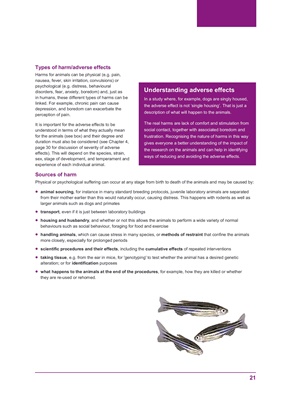
21
Types of harm/adverse effects
Harms for animals can be physical (e.g. pain,
nausea, fever, skin irritation, convulsions) or
psychological (e.g. distress, behavioural
disorders, fear, anxiety, boredom) and, just as
in humans, these different types of harms can be
linked. For example, chronic pain can cause
depression, and boredom can exacerbate the
perception of pain.
It is important for the adverse effects to be
understood in terms of what they actually mean
for the animals (see box) and their degree and
duration must also be considered (see Chapter 4,
page 30 for discussion of severity of adverse
effects). This will depend on the species, strain,
sex, stage of development, and temperament and
experience of each individual animal.
Sources of harm
Physical or psychological suffering can occur at any stage from birth to death of the animals and may be caused by:
animal sourcing, for instance in many standard breeding protocols, juvenile laboratory animals are separated
from their mother earlier than this would naturally occur, causing distress. This happens with rodents as well as
larger animals such as dogs and primates
transport, even if it is just between laboratory buildings
housing and husbandry, and whether or not this allows the animals to perform a wide variety of normal
behaviours such as social behaviour, foraging for food and exercise
handling animals, which can cause stress in many species, or methods of restraint that confine the animals
more closely, especially for prolonged periods
scientific procedures and their effects, including the cumulative effects of repeated interventions
taking tissue, e.g. from the ear in mice, for 'genotyping' to test whether the animal has a desired genetic
alteration; or for identification purposes
what happens to the animals at the end of the procedures, for example, how they are killed or whether
they are re-used or rehomed.
Understanding adverse effects
In a study where, for example, dogs are singly housed,
the adverse effect is not "single housing". That is just a
description of what will happen to the animals.
The real harms are lack of comfort and stimulation from
social contact, together with associated boredom and
frustration. Recognising the nature of harms in this way
gives everyone a better understanding of the impact of
the research on the animals and can help in identifying
ways of reducing and avoiding the adverse effects.